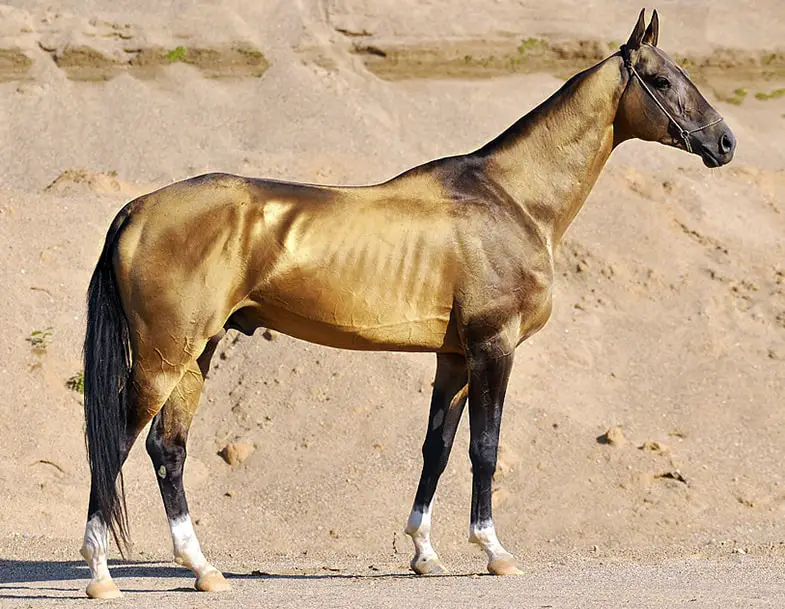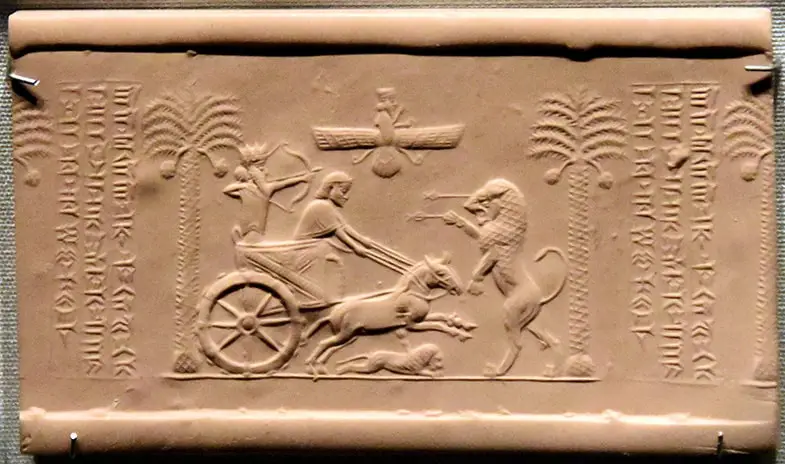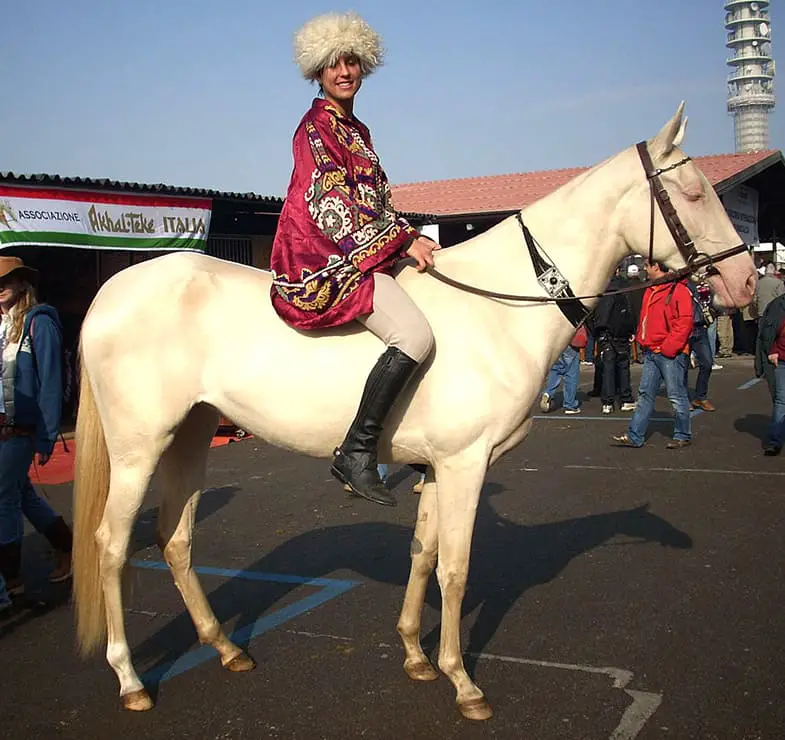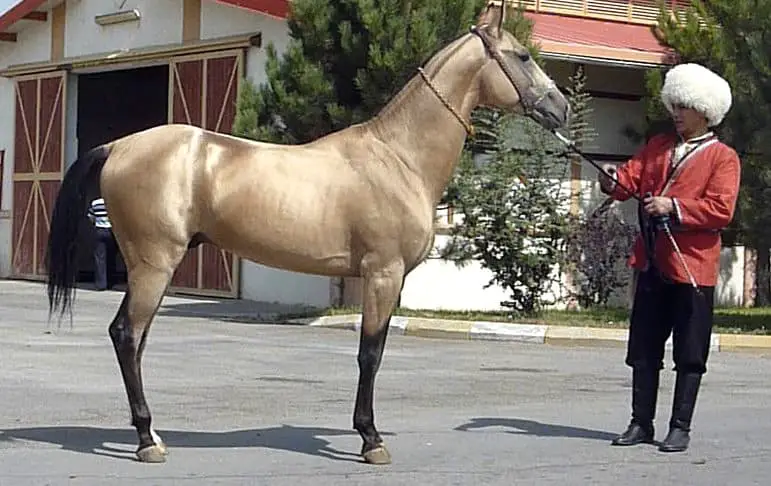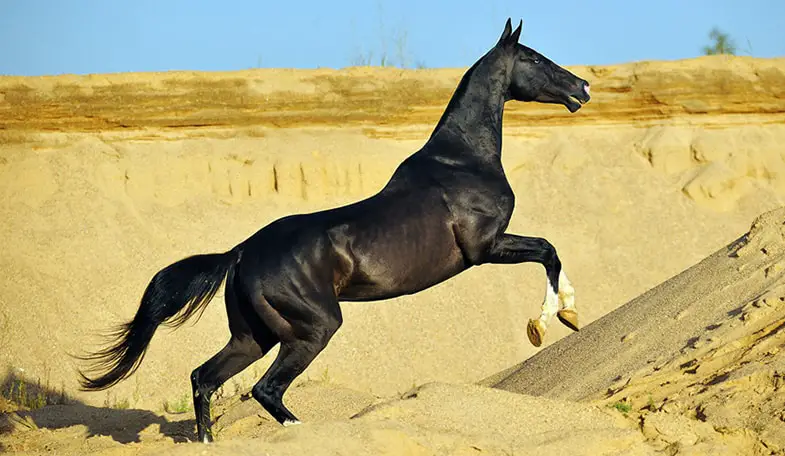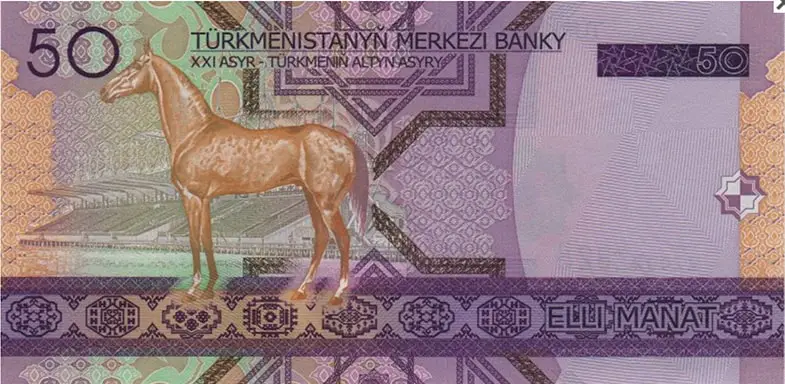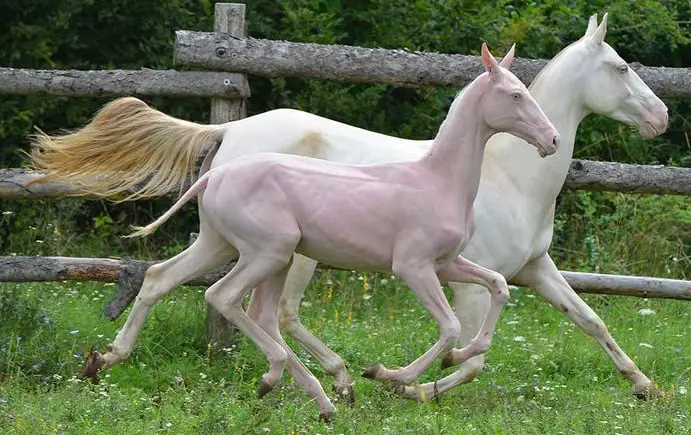With its heavenly-like sheen and elegant appearance, there’s no denying the Akhal Teke (pronounced Ah-Khal Teh-key) is a real eye-catching horse but there’s far more to this horse than its ability to turn heads. With their one-person attitude and incredible stamina, there really is no other breed quite like Akhal Teke. Read on the find out just how stunning this ancient breed is.
Height: Most horses stand between 15hh (60 inches) and 16hh (64 inches) although anything from 14hh (56 inches) to 16hh (64 inches) is allowed, with 15.2hh (52 inches) being the average height.
Color: Chestnut, palomino, and black are the most popular but bay, dun, and gray are also common, although any color is permitted.
Personality: The Akhal Teke is a highly intelligent, if somewhat spirited horse that is quick to learn. They’re wary of strangers but are devoted to their owners. They’re known for their stamina but also for their sensible natures.
Country of Origin: Turkmenistan
Registry: Akhal-Teke Association of America
One of the oldest (and purest) breeds in the world
Once described by the ancient Chinese as a heavenly horse that was said to possess magical powers, the Akhal Teke is believed to have descended from the now-extinct Nisean horse that made its way from North America to Asia around 10,000 years ago.
While much of the breed’s early history was only passed down orally it is known that the Akhal Teke, as we know it today, dates back to the 8th century. That said though, horses bearing an uncanny resemblance to them were first depicted in ancient artifacts as far back as 3,000 years. The Akhal Teke is believed to be the last pure strain of these horses and hasn’t changed much since those days.
A true desert horse
The Akhal Teke’s early days in the harsh arid desert of Turkmenistan’s Karakum desert has meant that it evolved into an extremely tough and hardy horse with phenomenal stamina. The lack of water and scarcity of food has meant that they can go for days with little water and have learned to survive on a low bulk and high protein diet (often supplemented with eggs).
The extreme heat during the day and subzero temperatures at night has also helped the Akhal Teke to be able to thrive in most environments around the world.
A close cousin of the Arabian
Over the decades there’s been a lot of debate around whether the Arabian created the Akhal Teke or vice versa but recent DNA evidence has been able to shed light on the contentious question. While the Akhal Teke is much older than the Arabian they are now known to be close cousins and are both descended from the same ancient ancestor.
That said though it’s important to remember that at one time horses were classed as types rather than as breeds so they may very well have bred with each other and helped to influence each other’s bloodlines.
The first official breeding farm was established in 1881
While the history of the Akhal Teke dates back many thousands of years in terms of official breeding farms this didn’t happen until 1881. After Turkmenistan lost the war against Russia, and had become part of the Russian Empire, General Kuropatkin who had been so impressed with the beauty and stamina of these horses, set up a number of official breeding farms in Turkmenistan and Russia. Before this time though the Akhal Teke wasn’t that widely known outside of Asia.
Much of their history is misreported
It wasn’t until the first breeding farms were established by the Russian Empire that the wider, English-speaking, world began to discover this ancient breed which has led to a lot of misunderstanding about its history. This of course isn’t helped by the fact that the Teke tribesmen only passed the breed’s history on verbally and never wrote any of it down.
This has resulted in many people mistakingly claiming the breed to be of Russian descent instead of being from Turkmenistan.
Live closely with nomadic humans
While many horses were integral to the lives of their creators, especially before mechanization, none of them are as important as the connection between the Akhal Teke and the nomadic Teke tribesmen, both were essential for each other’s survival.
The nomadic lifestyle meant that they needed to have a great deal of endurance and be able to travel vast distances quickly and with little food or water. This close connection also meant that the Akhal Teke soon learned to read humans and can understand what they’re being asked to do with just a simple gesture. Some horses are even said to be able to read their owner’s minds and know what they want them to do without very being asked.
A royal connection
Ever since ancient times, the Akhal Teke has been closely associated with royalty with people such as the 3rd King of Persia, King Darius (522 – 486BC) favoring the elegant breed as cavalry mounts. He loved these horses so much that they even featured on his royal seal.
King Darius wasn’t the only one to love the Akhal Teke though, Alexander the Great’s horse Bucephalus bore a striking resemblance to the Akhal Teke and is known to have come from the same region. There’s a tale that talks of Bucephalus being afraid of his shadow until Alexander the Great turned him into the sun and rode him, it’s said that the sun always stayed with him which is why the breed has a metallic sheen.
Known by many other names
It wasn’t until General Kuropatkin establish the official breeding farms in 1881 though that they became known as Akhal Tekes but before then they were known by a variety of different names such as Persian, Massaget, Parthian, and Turkmen. Some people even refer to them as Nisean because of their almost identical appearance and close connection to the ancient breed.
General Kuropatkin didn’t choose the name at random though, he named them after the Akhal oasis where he first saw them and took the Teke part from the tribe that originally bred them. It’s also worth mentioning that Akhal is Turkmen for stay which, given how closely the breed’s existence is intertwined with the Teke tribesmen, is quite apt. Mind you Teke means goat in English so maybe you can’t read too much into that.
The Akhal Teke was nearly wiped out (and is still at risk)
During Nikita Khrushchev’s reign (1958 to 1964) the Soviet Union was having a tough time feeding its citizens so Khrushchev ordered the slaughter of as many Akhal Tekes as possible. He claimed that ‘a single tractor was more than worth a 100 horses’ and that they were good for nothing more than meat. He banned the breeding of them and punished anybody who defied him. The Turkmen refused to eat them but this didn’t stop the mass slaughter which saw the loss of many thousands of horses.
It was only when Turkmenistan’s President Saparmuarat Niyazov, bowing to pressure from Mikhail Gorbachev, stopped the slaughter of the breed (and allowed breeders to once again breed Akhal Tekes) in the late 1980s that the Akhal Teke’s future looked a little bit brighter. At this time there were only around 1250 horses left.
Sadly though the future of this stunning breed isn’t any more certain today and is classed as endangered by the International Union for Conservation of Nature. The Equus Survival Trust has labeled them as endangered meaning there are between 100 and 600 breeding mares and around 25 to 150 foals born every year. While nobody knows the exact number for sure it’s generally thought that there are only 5,000 horses left in the world.
A true one person horse
If ever there was just one statement that could sum a breed up then the ‘one person horse’ title given to the Akhal Teke would have to be it. They are extremely loyal and so devoted to the owners that they are often jealous of strangers (and other horses) if they pay too much attention to their owners.
Some horses have been known to guard their owners like dogs and will attack other people, horses, and other animals if they perceive them to be a threat. That said though if you’re lucky enough to be that ‘one person’ then you’ll have a true friend for life!
Not a typical looking horse
Some people say that the Akhal Teke is a scrawny and gangly looking horse that isn’t a match for the elegance of the Thoroughbred but whatever you think there’s no denying they have a beauty and gracefulness all of their own. Okay, so the Akhal Teke may not be a ’typical’ looking horse, if there is such as thing, with its thin skin and small hooves but it’s probably the most refined horse you’ll find.
Rather than being scrawny, the Akhal Teke has a slender body with long, elegant legs and a narrow, straight head. Their ears are longer and set further forward than those of most other horses but this is due to their desert upbringing. They also have sparse manes and tails with absolutely no feathering on their legs at all. In fact, they’re often referred to as the equine equivalent of the greyhound or the cheetah.
Unlike most other horses Akhal Tekes also have almond-shaped eyes that are sometimes pale blue in color.
They have a metallic sheen
One of the most distinctive (and most loved) characteristics of the Akhal Teke is the metallic sheen that their coats have. It’s caused by the core of each hair being hollow, this refracts the like and makes it look like their coat is glowing.
The metallic sheen makes cream colored horses look golden while a gray horse can have a silver glow to it. Every color except black can show this effect but some colors, such as chestnut and palomino are more desirable.
Nobody really knows where the lack of opaqueness in the hair’s core comes from but it’s believed that it evolved as a means of camouflage in the sandy desert.
Phenomenal stamina and endurance
The Turkmen people are so proud of the Akhal Teke that in 1935 they organized a promotional event to showcase the breed’s stamina and endurance. They took a number of stallions and rode from Ashgabat (the capital of Turkmenistan) to Moscow in 84 days. That might not sound that impressive at first but when you realize that it was a distance of over 2,500 miles and that 225 of them were over the Karakum desert, which they covered in just three days with very little water, you can see why it was such an impressive feat. In 1988 the trek was recreated and once again the horses averaged 31 miles a day.
In 2009 an Akhal Teke named Alma carried French poet and Akhal Teke breeder Laurance Bougault from Isfahan in Iran to Paris via Turkey, Greece, and Italy. The trip lasted six months and covered 4,000 miles (6,500 km). [source]
Highly intelligent (but sensitive) horses
The Akhal Teke is far more intelligent than most other horse breeds, it’s helped them to not only survive a nomadic desert life but to thrive.
A smooth, floating gait
While the Akhal Teke isn’t considered to be a gaited breed it does, nevertheless, have a very smooth flowing gait that is said to make it seem as if the horse is floating above the ground. The reason for this is that their trot has an unusual footfall where each foot hits the ground separately, alternating between one foot being on the ground and then two diagonal feet being on the ground. This way of moving is due to the sandy terrain of their homeland.
The gallop of the Akhal Teke is long and easy while their jump is said to be more cat-like than horse-like. It’s also said that they are able to gallop down an uneven mountain path in the dark without putting a foot wrong.
Instrumental in the creation of the Thoroughbred
During the 17th and 18th centuries around 200 horses were exported to Great Britain to help with the development of the Thoroughbred but this is only half of the story. For many years it was believed that all three of the founding fathers were Arabians but it’s recently been discovered (through DNA testing) that one of the horses, Byerley Turk, was in fact a purebred Akhal Teke. Their influence doesn’t stop there though because Darley Arabian, while being an Arabian, is from the Munigi strain which is known to have a lot of Akhal Teke blood.
A few other Akhal Teke stallions have also played a part too, horses such as Lister Turk, White Turk, and Yellow Turk. Of course, at this time the Akhal Teke was known by a variety of different names and I wonder if the ‘Turk’ part of the name of these horses is an indication of the fact that they were Akhal Tekes instead of Arabians?
As well as being fundamental in the creation of the Thoroughbred, the Akhal Teke has also helped influence a number of other breeds such as the Trakehner, Ukrainian Riding Horse, Don, Budyonny, Karabair, and Karabakh.
A national emblem of Turkmenistan
The Akhal Teke is held in high regard in Turkmenistan (and many of the other former Soviet countries that make up Central Asia)c and can be found adorned on stamps from across the region. The breed also appears on Turkmenistan’s coat of arms as well as on banknotes. The government often gives the horses as diplomatic gifts to politicians and heads of state.
A versatile sports horse
While it was the breed’s incredible stamina and endurance that made them so popular, today they’re becoming more and more widespread as dressage horses. They can also be seen excelling in many other disciplines such as show jumping, eventing, pleasure riding, and even racing. Their use as cavalry horses is a testament to their versatility and courage.
Prone to genetic conditions
The Akhal Teke only has a small gene pool which means that the breed lacks genetic diversity which sadly makes them prone to a number of genetic conditions such as:
- Cervical vertebral malformation – Also known as wobbler syndrome, this is a condition where neurological deficits cause horses to have stiff, uncoordinated gaits.
- Cryptorchidism – One or both testes are missing which can result in other health or behavioral issues as well as making castration difficult. Horses still produce testosterone so can be temperamental.
- Naked foal syndrome – Or hairless foal syndrome as it’s sometimes called means that foals are born without any hair but can also have tooth and jaw abnormalities. They can also develop frequent digestive issues and diarrhea. Sadly this is always fatal with many foals dying within a few weeks although some can survive for up to two years.
Famous Akhal Tekes and owners
Over the years there have been a number of famous Akhal Tekes as well as some equally famous owners.
Famous horses
The 1960 Rome Olympic Prix de Dressage winner, Absent, was a black Akhal Teke stallion ridden by Sergey Filatow. After winning Olympic gold in 1960 he went on to win another five Olympic medals, far more than any horse has done to date.
While he may not be world-famous, Senetir was the first Akhal Teke to be imported into the States. In 1978 Phil and Margot Chase brought the stallion to their farm in Virginia and he went on to sire many Akhal Tekes.
Famous owners
In 1956 Nikita Khrushchev present a stunning stallion by the name of Melekush to Queen Elizabeth II of Great Britain. It was said that her grooms were unfamiliar with the breed and their metallic sheen so spent many days trying to brush the ‘dust’ out of the stallion’s coat. The Queen’s equerry later described the horse as the best horse he’d ever seen.
Related questions
Are Akhal Tekes good for beginners?
Akhal Tekes aren’t the best choice for beginners or novice riders, their spirited nature means they need an experienced rider. Likewise, when it comes to training they need to be handled gently, otherwise, they can become defensive and extremely stubborn.
How much does an Akhal Teke cost?
The rarity of the breed, combined with their status, means they often command a high price. The starting price is around $10,000 but their age, color, health, pedigree, training, and show record can all have an impact on the price. A well-trained show horse can easily sell for $35,000 to $40,000 but when factor in a good pedigree and desirable color it’s not uncommon for horses to reach in excess of $100,000.
I hope you found this article helpful. If you did I’d be grateful if you could share it please as it would really help me.
Recommended products
Over the years I have tried hundreds of different horsey products, from various blankets and halters to different treats. Some I’ve loved, others I’ve hated but I thought I’d share with you my top all-time favorite products, the ones I never leave the yard without. I’ve included links to the products (which are in no particular order) that I really think are great.
- Horse Knots by Reference Ready – If you’re like me and enjoy pocket reference guides then you’ll love this knot tying guide. These handy cards can easily fit in your pocket or attach to the saddle for quick reference. They’re waterproof, durable and are color coded to make them easy to follow.
- Mane ’n Tail Detangler – Even if you never show your horse you’ll need to detangle his tail from time to time (and possibly his mane too) which is always a challenging chore! I’ve found that if I run a little bit of detangler through my horse’s tails every few days it stops them from getting matted up and makes combing them easy, even if they’re coated in mud. I don’t know if I should admit to this or not but it also works wonders on my hair.
- TAKEKIT Pro clippers – Over the years I’ve tried a lot of different clippers and while some were obviously better than others I found these to be by far the best. They are heavier than a lot of other clippers but for me, that’s a good thing, it makes them feel more sturdy and hardwearing. On top of that they have a range of speeds so are just as good for clipping your horse’s back as they are his face. I also like the fact that they come in a handy carry case but that’s not for everybody. The company that makes them is super good and incredibly helpful too, a real bonus these days. The only thing I wasn’t keen on was the fact that it doesn’t come with any oil, but that’s not a major problem as it’s not difficult to buy lubricant.
- Shire’s ball feeder – There are so many boredom buster toys out there but I like to use these every day, regardless of whether or not my horses are bored. I find that it helps to encourage my horses to problem solve by rewarding them with treats (or pieces of fruit) but it also mimics their natural grazing behavior which helps to keep them calm and de-stressed.
- Horse safe mirror – This is a strange one that many people are surprised about but I like to put horse safe mirrors in the trailers as well as in the quarantine stalls. It helps to prevent the feeling of isolation by giving the impression of other horses being around. Being herd animals horses can get extremely stressed when they feel that they’re on their own but with these stick-on mirrors, they believe that at least one other horse is with them.
- Rectal thermometer – I know this isn’t glamourous at all but it’s vital for your horse’s well-being to be able to check their temperature and a rectal thermometer is the easiest way of doing this which is why I’ve added it to the list.
Shopping lists
I’ve also put together a few shopping lists of essential items that I’ve found helpful over the years. I’ve broken the lists down into different categories rather than put everything in one massive list 😉

